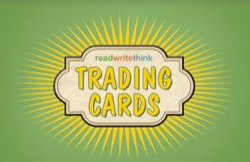Trading cards and the Common Core

We’ve always asked our kids to read. Informational text. Primary sources. Non-fiction. Fiction. Poetry. We’ve always asked our kids to write. Summaries. Research. Reviews. Reaction papers.
At least, that’s been the theory. Good social studies and history instruction has always included these things but I think that sometimes we can forget how critical reading and writing skills are to what we do. The Common Core, for better or worse, has been a good reminder for us. We need to have our kids read, write, and communicate much more.
The problem for many of us?
Uh . . . what does that look like again?
The answer often lies outside of the typical social studies / history resources and web sites that we’re used to using. One of those resources that we need to start using more is called ReadWriteThink. ReadWriteThink provides access to quality practices in reading and language arts instruction by “offering the very best in free materials.”
I like the word free.
And because ReadWriteThink partners with some biggies in the ELA world – the International Reading Association, the National Council of Teachers of English, and ThinkFinity – you know the free stuff you’re gonna get is golden.
Need an example? ReadWriteThink has over 50 interactive writing tools that you should be using as you jump back into the reading / writing world. A specific example that I think a lot of kids will enjoy is the Trading Card tool:
The Trading Card tool gives students an alternative way to demonstrate their literacy knowledge and skill when writing about popular culture texts or real world examples. This interactive allows students to create their own trading card about a real or fictional person, place, object, event, or abstract concept.
These cards are can be used with any type of book students are reading or subjects that they are studying, and make for an excellent pre-writing exercise for students who are writing narrative stories and need to consider characters, setting, and plot. Specific prompts guide student through the various types of cards, expanding students’ thinking from the basic information and description of the topic to making personal connections to the subject.
You could have kids use the tool to summarize a specific historical person or event. Have kids work in small groups to develop a series of cards that demonstrate change over time in the relationship between different historical groups or to highlight foundational knowledge they will use for further research. The tool also comes with a series of lesson plans tailored for grades 3-12 that you can use right away or modify to fit your own needs.
So don’t be afraid of the big, bad ELA wolf who’s knocking on your door. Let him in. He brought snacks.


















This is absolutely brilliant! Thank you so much for sharing. This is definitely getting added to my bag of tricks.
April,
It does look like a lot of fun! Good luck!
glennw
Reblogged this on Inspired by History and commented:
Fantastic teaching and reinforcement tool.
I have adapted this tool with students to create trading cards for Greek gods and goddesses. I called it “New Kid on the Mountain.” As the “New Kid” they read the myth stories to “meet” the gods and goddesses. It is a challenge for students to summarize the myth stories associated with each one. I had them evaluate character development by identifying the character’s home, appearance, and feelings. Then I asked them to determine story development by defining the problem, goal, outcome, actions, and interactions. They had to summarize to make the key points fit within the space provided. This required them to use good word choice to communicate their ideas. Then they created their own new god or goddess and wrote a myth story for the new god or goddess. The kids really liked comparing their trading cards and being able to create a new myth story.
Sheri,
Sounds awesome! Liked the idea of summarizing as well as creating a new myth.
Thanks for sharing!
glennw
Reblogged this on Storykeeper.